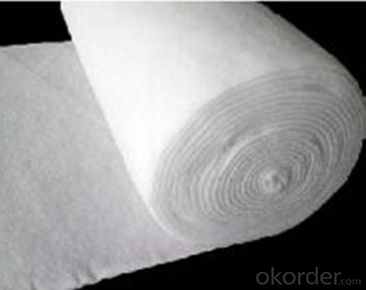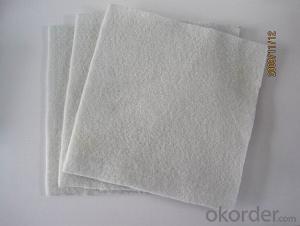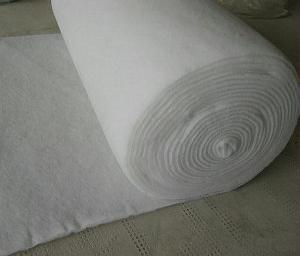PET Non-woven Geotextile of Earthwork Products
- Loading Port:
- China main port
- Payment Terms:
- TT OR LC
- Min Order Qty:
- 1000 g/m²
- Supply Capability:
- 1000000 g/m²/month
OKorder Service Pledge
OKorder Financial Service
You Might Also Like

Geotextile Specifications
Geotextile Type: Non-Woven Geotextiles
· Color: White
· Thickness: 3mm
· Breaking Strength,kN/m ≥: 12.5
· Elongation at Break,%: 25-100
· CBR Mullen Burst Strength,kN ≥: 2.1
· Sieve Size O90(O95),mm: 0.07-0.2
· Tear Strength,kN ≥: 0.33
Features and Benefits
Nonwoven structure, providing excellent surface friction and built-in elongation
Effective filter, with tight pore size (AOS=70) and high permittivity
High tensile strength, with excellent puncture and tear resistance
Range from 3.2 oz/sy (109g/sm) – 16.0 oz/sy (543g/sm)
Our Service
1.On a regular basis or as per your request,we entrust national testing agencies to conduct quality inspections
2. Strictly in accordance with the ISO9001-2008 international quality system standard,we monitor and manage the whole process throughout production,quality testing,and measurement to ensure product quality
3. For quality-related construction delay or substandard construction(except for damage or losses due to customer’s responsibility or irresistible natural disasters),we have refunding,replacement,and repair services.We will respond to customers’ feedbacks on quality issues within 24 hours.
4.In order to provide customers with comprehensive technical support,we will provide technical and other related information upon request in a timely manner.
5.In required,we will appoint specialized technicians to the construction site to give technical trainings to construction people,and offer technical guidance throughout the whole construction process.
6.For damage due to shipment and delivery,after we receive the complaint,we will check the issure through provided pictures and videos.If our responsibility is confirmed,we wil offer free replacement.
7.When the construction is completed,as your request,our technical staff may participate in the final acceptance.
FAQ:
Q: What kind of payments does jenor support?
A: T/T, L/C, Cash are accepted.
Q: Do you charge for the samples?
A: Accordeing to our company policy, the samples are free, we only charge the freight fee. And we will return the freight fee during the next order.
Q: Can you produce according to customers' design?
A: Sure, we are professional manufacturer, OEM and ODM are both welcome.
Q: Do you have other products?
A: Yes, please check the pictures:
- Q:Can geotextiles be used in the construction of artificial ponds?
- Yes, geotextiles can be used in the construction of artificial ponds. Geotextiles are often used as a lining material for ponds to provide reinforcement, filtration, and separation between the soil and water. They help to prevent erosion, control soil movement, and improve overall stability of the pond structure.
- Q:How are geotextiles used in railway construction?
- Geotextiles are commonly used in railway construction for various purposes such as erosion control, filtration, separation, and reinforcement. These synthetic fabrics are placed in different layers beneath the railway tracks to provide stability, prevent soil erosion, and improve drainage. They also help to separate and reinforce different layers of soil, preventing intermixing and maintaining the overall integrity of the tracks. Overall, geotextiles play a crucial role in enhancing the performance and longevity of railway infrastructure.
- Q:Can geotextiles be used in erosion control in agricultural fields?
- Yes, geotextiles can be effectively used in erosion control in agricultural fields. Geotextiles are permeable fabrics that can stabilize soil and prevent erosion by retaining sediment and allowing water to pass through. They are commonly used in agricultural practices such as slope stabilization, soil erosion prevention, and filtration. By placing geotextiles in areas prone to erosion, they can help to reduce soil loss, improve water quality, and enhance the productivity and sustainability of agricultural fields.
- Q:Can geotextiles be used in land reclamation projects?
- Yes, geotextiles can be used in land reclamation projects. Geotextiles are often employed to stabilize soil and prevent erosion during the reclamation process. They provide a barrier that separates different soil layers, allowing water to drain while preventing the loss of fine particles. Additionally, geotextiles can reinforce weak soils, increase their load-bearing capacity, and promote vegetation growth, making them a valuable tool in land reclamation projects.
- Q:What are the different installation methods for geotextiles?
- There are several installation methods for geotextiles, including direct placement, trenching, and mechanical installation. In direct placement, the geotextile is simply laid over the desired area and secured in place with stakes or sandbags. Trenching involves digging a trench and placing the geotextile in the trench before backfilling. Mechanical installation utilizes specialized equipment, such as a geotextile roller or a geotextile gun, to install the geotextile quickly and efficiently. The choice of installation method depends on the specific project requirements and site conditions.
- Q:Can geotextiles be used for soil reinforcement in embankments?
- Yes, geotextiles can be used for soil reinforcement in embankments. Geotextiles are commonly used in civil engineering projects to improve the stability and strength of soil structures. They are effective in preventing soil erosion, enhancing drainage, and distributing loads, making them suitable for reinforcing embankments and preventing slope failures.
- Q:How do geotextiles help in erosion control?
- Geotextiles help in erosion control by acting as a barrier between the soil and water, preventing erosion by filtering and stabilizing the soil. They provide reinforcement and support to the soil, reducing the impact of water flow and preventing the loss of soil particles. Additionally, geotextiles promote vegetation growth by retaining moisture, enhancing root development, and protecting newly seeded areas from wind and water erosion.
- Q:Is it possible to isolate permeated geotextiles and impervious geotextiles?
- Geotextile is permeable, and water, but the soil, from the filter effect, impermeable geotextile is geomembrane composite geotextile composite products, is impermeable and waterproof, I am specializing in the production of geotechnical materials,
- Q:Can geotextiles be used in subsurface drainage applications?
- Yes, geotextiles can be used in subsurface drainage applications. They are often used as a filter or separator in drainage systems to prevent soil particles from clogging the drainage pipes or channels while allowing water to pass through. Geotextiles can enhance the effectiveness and longevity of subsurface drainage systems by preventing soil compaction and maintaining the flow of water.
- Q:Can geotextiles be used in green or sustainable building practices?
- Yes, geotextiles can be used in green or sustainable building practices. Geotextiles are often utilized as a sustainable alternative to traditional construction materials. They can be employed for erosion control, soil stabilization, and drainage purposes. Geotextiles help reduce the use of non-renewable resources, minimize soil erosion, and improve water conservation. Additionally, their recyclable and biodegradable options make them an eco-friendly choice in green building practices.
1. Manufacturer Overview |
|
|---|---|
| Location | |
| Year Established | |
| Annual Output Value | |
| Main Markets | |
| Company Certifications | |
2. Manufacturer Certificates |
|
|---|---|
| a) Certification Name | |
| Range | |
| Reference | |
| Validity Period | |
3. Manufacturer Capability |
|
|---|---|
| a)Trade Capacity | |
| Nearest Port | |
| Export Percentage | |
| No.of Employees in Trade Department | |
| Language Spoken: | |
| b)Factory Information | |
| Factory Size: | |
| No. of Production Lines | |
| Contract Manufacturing | |
| Product Price Range | |
Send your message to us
PET Non-woven Geotextile of Earthwork Products
- Loading Port:
- China main port
- Payment Terms:
- TT OR LC
- Min Order Qty:
- 1000 g/m²
- Supply Capability:
- 1000000 g/m²/month
OKorder Service Pledge
OKorder Financial Service
Similar products
New products
Hot products
Related keywords
































